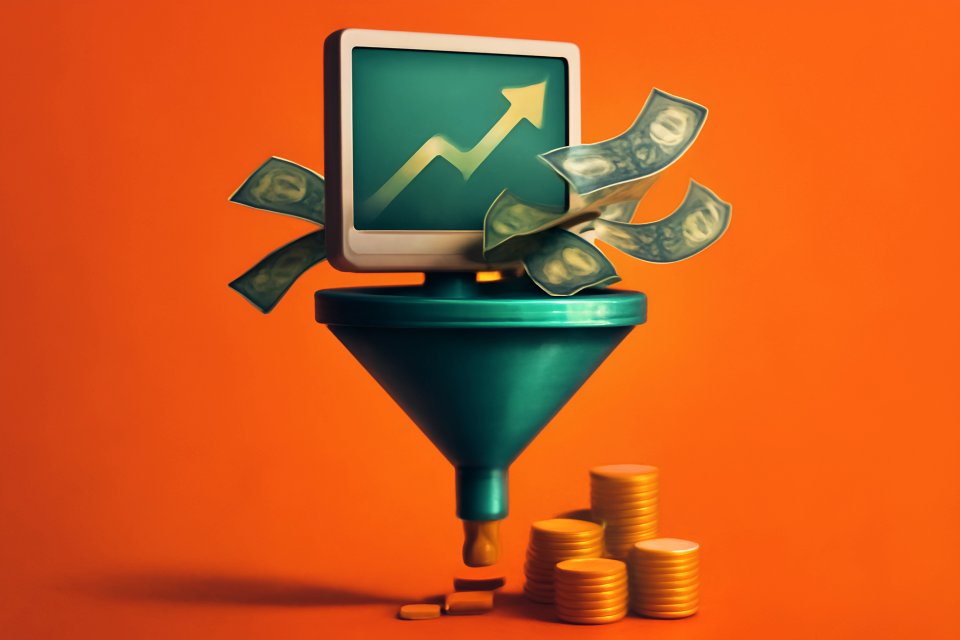
You're putting in the hours. Your side hustle is making some money, but you've hit a plateau, a ceiling you just can't seem to break through. You're relying on gut feelings and random tactics, throwing spaghetti at the wall and wondering what will actually move the needle.
This guesswork is the single biggest barrier to scaling. It’s a thief that steals your time, your money, and your motivation, leaving you exhausted and stuck in the same place month after month. You’re working harder, not smarter, and the dream of financial freedom feels like it’s slipping away.
The key to shattering that ceiling isn't more hustle—it's more clarity. It's time to adopt the CEO mindset for your side hustle by embracing data-driven analytics. This guide will demystify the numbers, showing you exactly what to track, which tools to use (even the free ones), and how to turn cold, hard data into actionable growth strategies that finally get you paid what you're worth.
Beyond Gut Feelings: Why Data is Your Side Hustle's Secret Weapon
Let's be honest. "Analytics" sounds intimidating, like something reserved for corporations with entire departments of data scientists. But the truth is, data is your secret weapon, the one thing that separates the side hustlers who stay small from the ones who build empires. It’s the difference between being busy and being truly productive.
Data pulls back the curtain and shows you exactly where your efforts are generating the highest return on investment. According to HubSpot, businesses that use data analytics to make decisions are significantly more likely to improve their customer acquisition and retention. Is it that one blog post driving 80% of your traffic, or that one social media platform bringing in all your best clients? Data tells you where to pour your gasoline.
More importantly, data helps you understand your audience on a profoundly deep level. It reveals who they are, where they come from, and what they really want—not just what you think they want. This allows you to make confident, profitable decisions about everything from setting your prices to launching a new product, transforming your venture from a guessing game into a predictable, scalable machine.
The Metrics That Actually Matter: Your Side Hustle Growth Dashboard
Forget drowning in a sea of spreadsheets and confusing charts. You only need to track a handful of vital signs for your business. Think of this as your simple, powerful "growth dashboard" that tells you the health of your side hustle at a glance.
For Content Creators & Bloggers
Your audience is your currency, and your content is your product. You need to know what resonates and what converts. Start by obsessing over your Traffic Sources to see if people are finding you through Google, Pinterest, or Instagram—this tells you exactly where to focus your marketing energy.
Next, identify your Top Performing Pages/Posts. These are your greatest hits, the content your audience is screaming for you to create more of. Pair this with your Email Subscriber Growth Rate, because your email list is the one audience you truly own. Finally, for those looking to monetize, tracking Affiliate Link Clicks & Conversions is non-negotiable; it’s the clearest path to understanding what your audience will actually pay for and is the first step in leveraging data-driven insights to boost your affiliate marketing ROI.
For Freelancers & Service Providers
For you, it's all about the pipeline. Your most critical metric is understanding your Lead Sources. Knowing whether high-value clients find you on LinkedIn, through referrals, or on your website is the key to finding more of them, a strategy that successful freelancers use to diversify their income streams.
Once you have a lead, your Proposal Conversion Rate tells you how effective your sales process is. If this number is low, it’s a red flag that your pricing, proposal, or portfolio needs a tune-up. To truly scale, you must calculate your Client Lifetime Value (CLV), which shows you the immense value of retaining great clients and encourages you to focus on long-term relationships over one-off gigs.
For E-commerce & Product Sellers (Etsy, Shopify, Print-on-Demand)
Your storefront is a machine, and every metric tells you how well that machine is running. The single most important number is your Conversion Rate—the percentage of visitors who make a purchase. According to Shopify, even a small improvement here can have a massive impact on your bottom line.
Next, look at your Average Order Value (AOV). This number reveals powerful opportunities for upselling, cross-selling, and product bundling to increase how much each customer spends. Of course, you must know your Top-Selling Products to inform your inventory and marketing focus, but don't forget to track your Cart Abandonment Rate. This metric is a goldmine for identifying friction in your checkout process that could be costing you sales every single day.
Your Data-Driven Toolkit: Analytics Tools for Every Budget
You don't need to spend a fortune to get world-class insights. The modern side hustler has access to an arsenal of powerful, and often free, tools that can provide all the data you need to make smarter decisions. The key is knowing where to start.
The Free Essentials (Start Here)
First, if you have a website, installing Google Analytics is non-negotiable. It is the gold standard for understanding who your visitors are, how they found you, and what they do on your site. It’s the foundation of your entire data strategy.
Don't overlook the power of platform-native analytics. Tools like Instagram Insights, YouTube Studio, and Etsy Stats are packed with valuable data about your specific audience. As Buffer's experts note, these built-in tools are often the best place to find actionable insights on post performance and audience engagement. Finally, never underestimate the power of a simple spreadsheet like Google Sheets to track your finances, client pipeline, or any other custom metric that matters to you.
Powerful Freemium & Paid Upgrades
When you're ready to level up, there are incredible tools that won't break the bank. To understand why users behave the way they do, install a tool like Microsoft Clarity. Its free plan offers heatmaps and session recordings, literally showing you where people are clicking and getting stuck on your site.
For SEO, Google Search Console is another free must-have that shows you the exact keywords people are using to find you. When you're ready for more advanced keyword research, you can explore paid tools like Ahrefs or Semrush. For a deeper dive into the best platforms for your needs, check out this comprehensive review of digital marketing tools for online earnings to help you choose wisely.
From Data to Decisions: A Simple 3-Step Framework for Growth
Having data is one thing; using it to make money is another. This simple, repeatable framework turns your numbers into decisions and your decisions into dollars. This is how you move from being a passive observer to an active CEO of your side hustle.
Step 1: Review (The 30-Minute Weekly Check-in)
Consistency is more important than intensity. Block out 30 minutes on your calendar once a week—say, every Monday morning—to look at your key metrics from your growth dashboard. The goal isn't to obsess over daily fluctuations but to spot meaningful trends over time.
This regular review process is a habit shared by the most successful entrepreneurs. It keeps you grounded in reality and prevents you from chasing shiny objects. Make this a non-negotiable appointment with your business, and you'll already be ahead of 90% of your competition.
Step 2: Analyze (Ask "Why?")
This is where the magic happens. Looking at the numbers isn't enough; you have to ask the most powerful question in business: Why? Go beyond the "what" and form a hypothesis.
For example, you might see: "My traffic from Pinterest doubled last week." Don't stop there. Ask why? "Oh, it's because that one pin about 'passive income ideas' went viral." Or perhaps: "My proposal conversion rate dropped this month." Why? "I raised my prices but haven't updated my portfolio to justify the increase." This critical thinking step turns raw data into business intelligence.
Step 3: Act (Run Small Experiments)
Based on your "why," create one small, measurable action item to execute this week. This isn't about overhauling your entire business; it's about making small, iterative improvements based on real feedback from your audience and customers.
Using our examples: "Since the 'passive income' pin did well, this week I will create two new pins for that same blog post with different designs." Or: "To improve my conversion rate, this week I will update my portfolio with my two best projects before sending any new proposals." This cycle of Review -> Analyze -> Act creates a powerful feedback loop that guarantees continuous growth.
Stop Guessing, Start Growing
Data isn't an intimidating monster hiding in a spreadsheet. It's a roadmap, a clear and simple guide showing you the fastest path to your goals. The process is simple: Review your key numbers, analyze why they're changing, and act on those insights with small, consistent experiments.
You don't need a degree in data science or a massive budget to make smarter decisions for your side hustle. You just need curiosity and a commitment to listening to what your audience is already telling you. Start with one metric, stay consistent, and you will build the unstoppable momentum needed to scale your income and achieve the freedom you deserve.
What is the #1 metric you're going to start tracking for your side hustle this week? Share it in the comments below!
Frequently Asked Questions (FAQ)
Q: I'm just starting my side hustle. Is it too early for analytics?
A: Not at all! It's the perfect time to build good habits. Start by tracking one simple metric, like your monthly income or your Instagram follower growth, to get comfortable with the process.
Q: How often should I check my analytics?
A: A weekly check-in is ideal for spotting trends without getting overwhelmed. Avoid checking daily, as numbers can fluctuate and cause unnecessary stress and reactive decision-making.
Q: What's the single most important metric for a side hustle?
A: It depends entirely on your primary goal right now. If you need to grow your audience, it's traffic or follower growth. If you need to increase profitability, it's your conversion rate. Choose the one metric that aligns with your biggest, most urgent priority.














